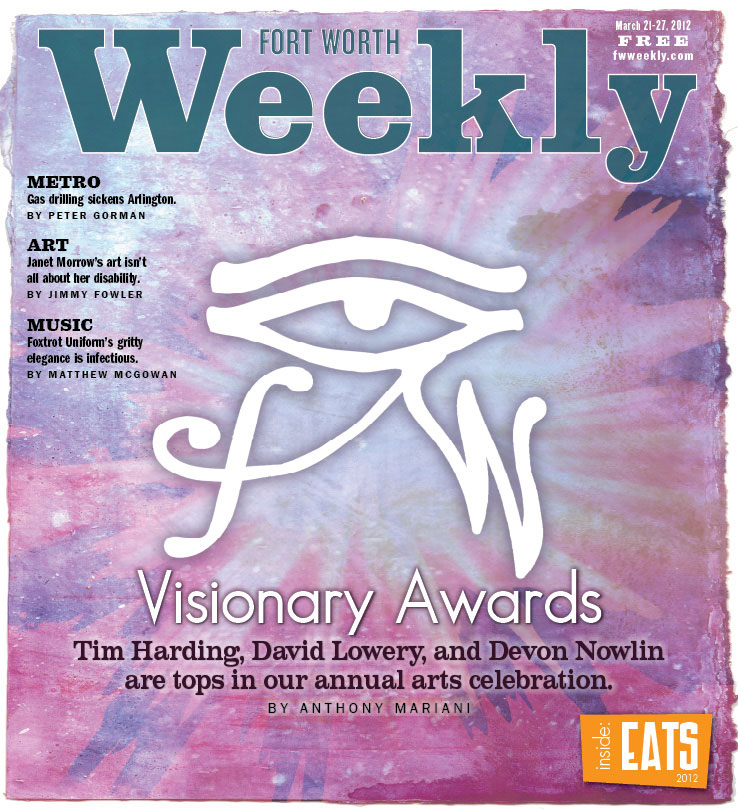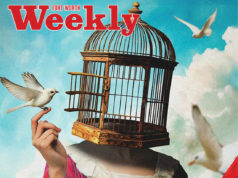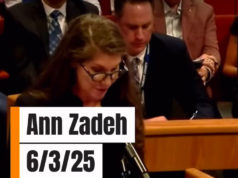Here’s a conundrum: How can Fort Worth have such an incredible array of art-related institutions and not be an “art town”? (At least not yet.)
Yes, there are arty aspects of the Fort that are the envy of many other, older, much larger cities. The tri-headed brilliance of the Amon Carter Museum of American Art, Kimbell Art Museum, and Modern Art Museum of Fort Worth make Fort Worth the museum capital of not just Texas (sorry, Dallas; sorry, Houston; sorry, Austin) but arguably the entire Southwest.
Fort Worth is also home to a world-class symphony, ballet company, opera company, and international film festival, and the city’s academic institutions produce bright young artists of all disciplines. The theater scene is lively, and the quadrennial Van Cliburn International Piano Competition is the pre-eminent competition of its kind in the world.
So why isn’t Fort Worth considered an art town? Why would an established visual artist tell an up-and-comer seeking career advice to go to Dallas? (Names have been removed to protect the innocent. And the guilty.) Are Fort Worthians simply too enraptured by their Cowtown heritage to care about anything not bovine or floral, forcing progressive artists out of town?
What we do know is that too much of what happens here –– from painting to dance to theater –– is on the safe side. And nearly every progressive artist in town will tell you that no one with any power is helping create any demand for progressive art, which is where the problem starts.
Maybe to help alleviate the stress, we recently created the Visionary Awards, three $500 cash prizes awarded to three outstanding up-and-coming fine artists chosen by a committee of esteemed professionals. Joining last year’s inaugural class of painter Michelle Brandley, filmmaker Andrew Disney, and multimedia artist Micah Yarborough are three unique, really visionary artists: multimedia artist Tim Harding, filmmaker David Lowery, and painter Devon Nowlin. All three of them produce cutting-edge work and are also steeped in traditionalism.
Where can you see their stuff? Well, with some exceptions, not here.
“Maybe it’s just that whole [progressive] collector base has to be built up,” Harding said. “There has to be a higher demand here for interesting art. Maybe just everyone’s going to Dallas to buy their art. Maybe the rich people of For Worth still just like their landscape paintings of horses and cattle, not to stereotype.”
Harding said he doesn’t have to travel to Dallas for museum shows –– all of the best are right here in his backyard. But galleries? “If I want to go to gallery shows, I have to go to Dallas, even though I’m not always floored by what I see there,” he said. “It is weird. We get the museums, but Dallas has all the galleries.”
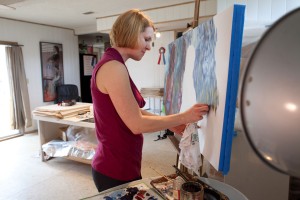
There are fantastic academic, mostly not-for-profit galleries here that offer mostly adventurous fare from mostly non-established (read: young) artists (Gallery 414, Fort Worth Contemporary Arts, Fort Worth Community Arts Center, Brand 10 Art Space, Gallery 76102, Atrium Gallery). And there are for-profit galleries whose walls are covered in mostly friendly, non-adventurous artwork (Milan Gallery, Edmund Craig, Galerie Kornye West). But with the exception of two fine galleries –– Artspace 111 and William Campbell Contemporary Art –– Fort Worth really doesn’t have progressive spaces hospitable to up-and-coming local artists.
“I’m so lucky to be an artist who can work as an artist in my hometown,” Nowlin said. “Fort Worth’s a great town for art and artists, but it’s very traditional in the gallery scene, and the museums are great, but there are these lines of separation between the artists and the dealers and the dealers and the collectors, and there are all these really traditional and well-defined boundaries for artists and for people who want to experience art.”
In other words, Fort Worth has room for the big boys and the tiny tots but no one in between.
With our little award, we’re hoping to inspire a bit of change, to foster a place for the in-betweeners, even if that place exists only in the wonderland of news media.
********
Devon Nowlin is primed for mainstream success and determined that none of her integrity will be lost in the process. The 32-year-old native Fort Worthian produces paintings that are traditionally representational enough to please even the most conservative collector but experimental enough to sate adventurous tastes. That she’s also an ebullient presence is likely to help her along the way.
“Setting aside who she is as an artist, Devon is a really good person,” said veteran multimedia artist, Art Corridor II curator, and noted art prankster Christopher Blay. “You can’t slap paint on that and hang it on the wall, but when it’s all said and done, you get both a badass painter and one of the most professional artists I know.”
Nowlin’s current crop of paintings hinges on mirror images, a motif that began appearing in her work about a decade ago. The visual duality leads to some borderline surreal imagery. In “Reflection in HD-3D: Original,” a young, slender woman with cropped dirty-blonde hair, obviously Nowlin, is shown from the shoulders up looking into a mirror, the background a hazy swirl of fading pinks and blues –– two hands reach up from beyond the bottom of the frame toward the faces, a hand for each face, but the hands aren’t mirrored reflections of each other, which is definitely creepy but in a good, cool, messing-with-your-head way.
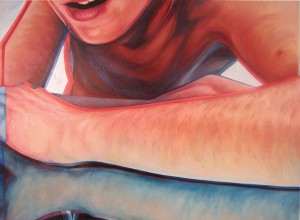
Her work is also very filmic, conceptually and, recently, formatically. Working almost entirely with the figure, Nowlin depicts mostly young men and women (and, occasionally, children or older people) in familiar contexts –– a backyard, say, or in nature –– and either poses her subjects in certain, unremarkable positions or, in group pieces, plays subjects off each other, their gestures suggesting everything from love to repulsion to mystification. In terms of form, Nowlin has begun subtly outlining and highlighting her figures in bold but unobtrusive reds and blues, like an old TV set on the fritz. Moving pictures, however, have always been influential on her work.
“I’ve always been tied to that photographic source,” she said. “I look at a lot of photography and a lot of painting, obviously, but more and more I’m looking at film and thinking of landscapes, figures in a landscape.”
For as long as she can remember, Nowlin has been encouraged to pursue art. Her mother’s side of the family was particularly helpful. “I had enough [artistic talent] in my family so that an artist was something that you could be,” she said. “My family has always been very supportive of me.”
In high school at Western Hills, Nowlin studied under legendary art teacher Helen Silvestri, who died at the age of 79 in October 2011. “I credit her for why I’m still a representational painter,” Nowlin said.
In Nowlin’s senior year, she won a district award in the Congressional Art Competition for U.S. high school students. Her winning entry was a photorealist painting of assorted junk in her parents’ backyard. “That’s still on my resumé,” she said. (The piece is still in her possession.)
To study art after graduation, Nowlin chose the University of North Texas, whose art program is one of the best in the state. UNT’s close proximity to home was a plus.
[pullquote_left]Are Fort Worthians simply too enraptured by their Cowtown heritage to care about anything not bovine or floral, forcing progressive artists out of town? [/pullquote_left]Her fascination with the figure really took hold there, she said. After earning her bachelor’s degree in art in 2004, Nowlin worked for a handful of years as an instructional assistant at Tarrant County College, working with faculty members and helping curate the Southeast campus’ popular gallery. At TCC, she said, she really began to sense the limits of her bachelor’s degree. Friends and co-workers encouraged her to pursue her Master of Fine Arts degree.
“I think that [an MFA degree] helps simply because there’s a lot of competition for very few real possibilities for jobs and income, and it’s kind of a vetting process too for artists,” she said. “You can definitely lead a really happy professional life without [an MFA], but it helps nowadays.”
Her first choice was Texas Christian University. At the time, her technique was pretty much established. What she got out of TCU’s MFA program, she said, was a strong conceptual foundation. “I was trying to focus on what my concepts were, what I could do that would be of my own voice or stand apart from other artists’ works,” she said.
Her inherent fascination with people produced that focus. “I will use the figure to be my attachment, my interest in the piece,” she said. “Now as I’ve reflected more and more on why I stay working with images of people, it’s because I’m endlessly fascinated by all of the intricacies of interpersonal interaction and what kind of narrative I can get out of that in a painting.”
Like such famous artists as John Currin and Lisa Yuskavage, Nowlin is inspired by the concept of the gaze, a mid-century feminist theory underlining the objectification of women in mainstream media, originally in film but now in pretty much any art form.
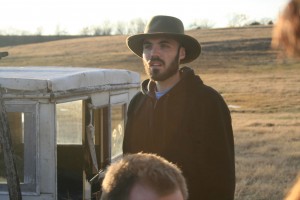
“The readings on that deal with voyeurism and exhibitionism and masculinity and femininity, a female but one that also feels in-between,” she said. “I think that really fascinated me, and how do I look upon the people I want to [paint]? … There has to be some connection to me to want to spend hours with this person, by bringing them to life on canvas, and in my own made-up narrative that goes along with all of that, I started realizing it was very tied to objectification or desire for some kind of intimacy, like a muse.”
Nowlin graduated from TCU with her MFA in studio art in 2009. She’s been married for six years and lives with her husband and four dogs in River Oaks. For the past several months, she’s been working full time as manager of Fort Worth Contemporary Arts, a TCU gallery that’s one of the most adventurous in North Texas. She’s also a founding member of the Homecoming Committee, a new artists’ collective whose leaders are so serious about art that they’re willing to poke fun at it. Their first exhibit/event, which took place in a makeshift gallery in the West 7th Street corridor last winter, involved the construction of a spaceship (yes, a spaceship), their severely cheeky entry in a competition for a grant from NASA. Some horrible, humorless people might say that the resulting star-voyager resembled, well, a hunk of junk.
Homecoming Committee, Nowlin said, “is for us as artists to work collaboratively and really push ourselves artistically, to have something else that we can contribute time and energy to beside our own work, but [Homecoming Committee] is also to create events. … We want to have events where the audience and participants feel that they have a stake in what we’re doing and can come away with a really great experience.”
Up next for the Homecoming Committee: Hands on an Art Body, a sort of devilish auction in which bidders must remain in physical contact with particularly painful artworks created by committee members –– the last bidder standing wins the piece –– and Total Station Domination, in which committee-member-made short films are screened on random flat surfaces around town, “pop-up drive-in sites,” Nowlin said. Spearheaded by TCU MFA student Bradley Brown, the Homecoming Committee, Nowlin said, serves a vital purpose: “We want to find some creative ways around [the disconnect between artists, galleries, and collectors] or to break down those boundaries.”
Hands on an Art Body will take place in May at Oliver Francis Gallery in Dallas.
********
Cinema, naturally, was also a huge part of filmmaker David Lowery’s childhood. “My earliest memories … involved Star Wars,” 31-year-old Lowery said. “It was a very, very important piece of my development.”
His fascination with cinema deepened when his parents gave him a book on how the space opera was made. David was about six years old at the time and did not have access to a video camera. However, he always wrote scripts, created props, planned things out. Once or twice a year, he recalled, a relative who owned a video camera would come to town, and young David would go nuts with the machine. In junior high school, a friend would let David use his video recorder. In high school, David used money from his first job to buy his own device.
One of nine children, Lowery was born in Milwaukee but relocated with the family to Dallas for his father to teach at the University of Texas at Dallas, not far from Lowery’s mother’s hometown of Fort Worth. His family, he said, has always been completely supportive of his passion for film. “I could not have done any of this without their help,” Lowery said. “They put up with a lot of me running out of money.”
Lowery’s lean years, he said, were born of his “stubborn independence.” He didn’t take the traditional routes of college or film school (though he attended UT-Dallas for several years, studying English literature). Instead, he just made films. “I’ve always made my own way,” he said. “Maybe it would have taken a little longer, maybe not, if I had gone to film school, but that’s just the way I do it.”
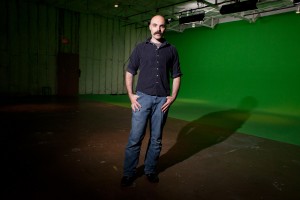
One of the main reasons Lowery didn’t finish college is that he sold a script for a TV pilot to Paramount Pictures. Though the project –– “something along the lines of Lost,” Lowery said –– never got made, the 13 months he spent on it helped him break into the industry. When he’s not making his own films, he’s editing other people’s, including ones by some high-profile directors.
Something of a nomad, Lowery has lived in Fort Worth and a lot of other places, but he considers Dallas home. He says he’d never move to the Hollywood area for good. “Being there is important, especially for someone early in their career,” he said. “It’s helpful to go out there and meet people in person. It’s helpful to have a face to go with a name, but it’s also very valuable to not be there full time. You just get caught up in the work. It’s nice to live outside that bubble, to be able to take some breathers here and there.”
In 2007, after learning that his TV pilot was not going to be produced, Lowery began work on his first feature. St. Nick was shot entirely in Fort Worth, specifically in the historic Fairmount District on the Near South Side, and is particularly notable for its minimalist, meditative texture. Starring a real-life 11-year-old brother and 9-year-old sister, St. Nick was an official selection in the annual SXSW Film Festival and was completed with help from a grant from the Austin Film Society. Like most of Lowery’s films, St. Nick was produced by award-winning Fort Worth filmmaker James M. Johnston and his production partner, Dallasite Toby Halbrooks, together known as Sailor Bear.
“David, as a writer — which bleeds into directing — has a great handle on true and compelling characters in a true, compelling story that’s packaged in a way that goes beyond boring, mundane, college-age kids’ stories,” Johnston said. “We love big movies as much as small-budget films, and David does that. … His movies are slow but still have that exhilaration. It’s not just masturbatory art. It really does respect the audience, and I think that’s important for art-house cinema.”
Lowery and Johnston met when Johnston answered an ad Lowery had placed for film crew members in the late 1990s. Lowery promises that no one will ever see the result of that initial collaboration, 1999’s Lullaby. “I knew nothing about making films,” Lowery said. “It was very amateurish. I’m proud of it. I made it. That was basically our film school.”
Lowery has come a long way. Last year, his most recent feature, Pioneer, starring singer-songwriter Will Oldham and produced by Sailor Bear, screened at the prestigious Sundance Film Festival.
In July, Lowery will begin pre-production on his next feature, Ain’t Them Bodies Saints, a ’70s-era odyssey across the Texan countryside undertaken by an escaped prisoner looking for his wife and daughter, with funding from the Sundance Institute. The timing of Lowery’s embarkation coincides with a trip that producers Johnston and Halbrooks will make to Park City, Utah –– they’re two of only six fellows chosen to participate in Sundance’s Feature Film Creative Producing Lab, a five-day powwow in which up-and-coming feature film producers work with accomplished creative advisors. (In January, Lowery participated in the film festival’s writing lab.) As part of the producers’ fellowship, Sundance will provide funding for the film throughout the year.
“This is the first time dealing with larger sums of money for production,” Lowery said. “There’s the whole issue with taxes. … Hopefully, we’ll work things out to be able to make the movie affordably in Texas. … That means a lot to us to be able to do that.”
For Lowery, Texas is special –– he feels he wouldn’t have been able to film St. Nick without Fort Worth’s Fairmount District. “I think Will Rogers said, ‘That’s where the West really begins,’ ” Lowery said. “There’s a sense of the Northeastern influence in Dallas, but that starts to fade away in Fort Worth.”
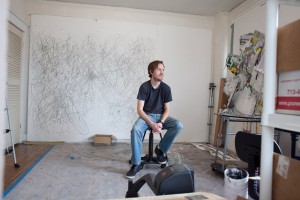
Lowery remembers his parents driving him from Dallas to Fort Worth to visit his grandparents when he was a kid and noticing the slow fading away of that Northeastern influence as Fort Worth drew closer. “It felt unruly, wilder,” he said.
The Fairmount District was particularly appealing. “I love that sense of history there,” he said. “You’ve got old houses –– some in good shape, some not –– and decaying old mansions right next to well-kept houses. … Everything feels lived in, and that texture of history is very important to me. In Dallas, everything’s new or torn down and rebuilt. The general feel you get in Fort Worth is lived-in. I like that a lot.”
Lowery loves being able to stand on the edge of the city and look out at unmolested countryside. “Fort Worth affords that to a greater degree than Dallas,” he said.
Lowery recently married actor Augustine Frizzell, so he’s settled down to an extent, in Dallas. He’ll keep traveling for work, though –– and probably filming in the Fort.
********
MFA degrees can be a lot of fun. After Fort Worth multimedia artist Tim Harding graduated from TCU with his Master of Fine Arts degree in 2010, he had a bit of a hard time finding work –– at least art-related work. “I worked for laundry service at TCU,” he said. “It was the worst job ever. I basically collected bags of laundry for lazy, spoiled TCU kids who don’t know how to do their own laundry. I would take it and drop it off somewhere for people to wash and then pick it up and return it back to them.”
Fortunately, his laundry purgatory lasted only about a semester. “It was terrible, terrible,” he said in an interview at Avoca Coffee recently, looking legitimately disturbed. “I was, like, I have my master’s degree, and I’m sitting in the back of a truck collecting laundry.”
Harding, 28, began picking up the art-related work that still keeps him busy –– though he still spends lots of time on the road. He now has a series of teaching gigs that put plenty of miles on his car: Tarleton State University in Stephenville, Texas Woman’s University in Denton, and TCC.
The Irving native had never spent much time in Fort Worth until, right after earning his bachelor’s degree at TWU, he moved here in 2008 for graduate school. “I fell in love with Fort Worth,” he said. “It’s really a great town, and that’s why I’m still here.”
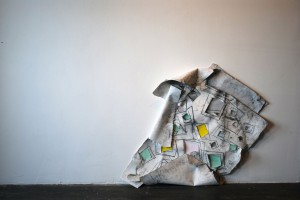
As an artist, Harding really manifests the concept of visionary. His work is painterly, mostly in an abstract-expressionist way, but paint is not his medium of choice –– rather, he’s used lights and extension cords. His 3-D-graffiti-esque work has hung at Gallery 76102 (at the University of Texas at Arlington’s satellite campus in downtown Fort Worth) and the Fort Worth Community Arts Center, and he was the only Fort Worth artist chosen to participate in the Texas Biennial, a statewide celebration of adventurous art. Feeling that his lights/extension-cords work has become redundant, Harding has given himself a new challenge for a show opening in April in Austin’s Big Medium gallery. For Putting Humpty-Dumpty Back Together Again, Harding is cutting out literally hundreds of scribbles in pencil on a massive piece of paper for him to reassemble the day before the show on another piece of paper. “It’s kind of like I’m custom-making my own confetti,” he said. “Part of it is supposed to be this fun exercise in the absurd. … A lot of my work has involved improvisation, going into a space and responding to it, and in a roundabout way I’ve been trying to rely more on chance than improvisation. … I’m just trying to challenge myself.”
Harding also sees some political import in the installation/piece. “It could be read as a kind of political statement, the idea of going back and trying to put back together something in the way that it was,” he said. “People are looking backward” to accomplish that feat.
When he was growing up in Irving, Harding, bereft of any outside influences, began drawing. “I was probably the only kid in elementary school and junior high who looked forward to art class more than P.E.,” he said.
He went to Northlake College in Irving with the intent of becoming a graphic designer. He quickly realized that the discipline wasn’t for him and switched to a painting major. He was encouraged by one of his professors to pursue painting at TWU, a “small, cozy, nurturing environment,” he said, noting that he was insecure about his abilities at the time.
Toward the end of his time at TWU, Harding began experimenting with multimedia components. By the time he got to grad school, he had shelved painting altogether in favor of “dimensional elements,” he said. Realizing that he could “draw” with extension cords and lights, he said, was eye-opening –– and TCU’s faculty was extremely supportive. He credits Frances Colpitt with turning him onto some of his most significant influences, Southern California’s light and space artists from the 1960s and ’70s.
Harding’s work also has conceptual roots in early-Modern abstract-expressionism. His pieces are large and chaotic. “I’ve always been a go-big-or-go-home person,” he said. “I’ve never really done small work. To some people, it might be over the top, but it really allows the work to impact a person, to kind of hit them over the head.”
In addition to running laundry back and forth after grad school, Harding picked up some gigs assisting Vernon Fisher, easily Fort Worth’s best-known Modern artist. Like Nowlin, Harding is a founding member of the Homecoming Committee. That winter opening was “the most fun I’ve had in the name of art-making,” he said. “It was a big party.”
For all he knows, viewers who saw the “spaceship” might have thought “it looked like trash,” he said.
But his opinion couldn’t have been more different. “I thought it was beautiful,” he said.
The point of the Homecoming Committee, he said, is “trying to get the community involved in art-making. There’s a disconnect between us artists and people who aren’t as involved in the arts.”
The event was a success, he said, based on the responsiveness –– and size –– of the audience. He estimates that more than 100 people turned out.
Harding also has joined 500X Gallery, an artist-run space in Dallas. There’s no similar organization/gallery in Fort Worth. “It’s strange,” Harding said. “Fort Worth is ripe for so much potential. … It just needs more community support. Maybe that’s part of the Homecoming Committee’s [responsibilities]. If that opening is any indication, there’s obviously support to be had, because there were a helluva lot of people there … but I’d like to see more galleries.”
Pretty often, Harding will find himself driving around the Near South Side, eyeing seemingly abandoned structures or buildings and thinking, “Hmm, I wonder what it would take to get my hands on that?”
Harding, Fisher said, has “talent, energy, and a good idea. What he needs is a trust fund.”
[box_info]
Fort Worth Weekly’s Second Annual Visionary Awards
6-9pm Thu at Artspace 111, 111 Hampton St, FW. $20-30 (includes complimentary food and adult beverages and unplugged performances by Telegraph Canyon and Brenna Manzare). 817-692-3228.
[/box_info]



